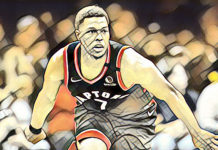<em>L</em><em>es Nombrils</em>, or <em>The Bellybuttons</em> in English, is a Quebecoise comic book created by Maryse Dubuc. The series follows three girls in high school, Karine, Vicky, and Jenny, and their everyday lives. Over the course of the books, love is found and lost, and enemies are made, but their crazy friendship always prevails.
I think my history with this series begins about 10 years ago at my local library, or maybe my elementary school library. Either way, I recently came across it again this past summer in Quebec, read all available volumes in French, and then bought the most recent volume from Amazon. There are now seven books, though only the first three can be officially purchased in English.
Going in, I thought this was a normal goofy comedy about three girls, high school, the typically young adult novel problems of boys and homework, and blah blah blah. Four volumes in, however, shit gets freaking real. I won’t spoil anything, but the story is insane as the series progresses. A lot happens, so much so that a lot of people can relate to one, if not all, of the protagonists and their troubles.
To begin, the three main characters are Karine, Vicky, and Jenny, probably in that order of importance. Vicky and Jenny are the “most popular girls in school” type of characters who all the boys want to date and all the girls hate. Karine is their friend/doormat who somehow sees the good in these two obnoxious people, but is basically the butt of their jokes 80 per cent of the time.
The first volume is the most typical “comic book” so to speak, where it’s about everyday life and there is not a lot of plot outside of Karine being interested in one boy who is interested in Vicky and Jenny. Vicky and Jenny, however, enjoy foiling any chances of these two getting together. You begin to seriously question why Karine is friends with these jerks, but the issue is addressed later in the series.
<em>Les Nombrils</em> is told in panels, similar to newspaper comics, but spans an average of 10 to 16 panels per page, depending on what is happening. The maximum is 16 panels per page, which makes for a good set up for some pretty fair jokes. One page is one joke. Stories can span multiple pages, but jokes will always end on the last panel of the page. The first three volumes follows this comic book style with the most vignettes of one-time actions, events, or occurrences. Volume four is when things really start to pick up in terms of plot.
This is, first and foremost, a comedy series. There are dramatic moments, sad moments, legitimately unexpected twists, but it’s still a comedy. I’ll admit, a lot of the humour went right over my head on my first read because I read it in French; I literally was not understanding the jokes. I’ve yet to read the English version so I’m not sure if I’m outside the humour’s target demographic. When I translated some words here and there, it was pretty funny. I can’t say I’ve ever laughed out loud (again, mostly because it was in French and I only understood about 60 per cent of what was happening), but it’s all good reading.
I picked up this series for learning purposes: a comic book has a lot of dialogue, but the pictures help further understanding what is happening. For anyone at my level of French, which is about advanced-intermediate, I would highly recommend this series for pleasure, practice, and to learn some interesting Quebecoise speak. For those who don’t speak any French, I would still recommend the series, but be aware that less than half of all volumes are unavailable to you, so you’ll be missing out on a lot.
Final recommendation: a must read.
































